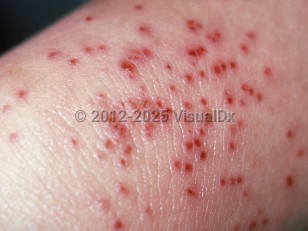Eczema herpeticum in Adult
Alerts and Notices
Important News & Links
Synopsis

Risk factors that have been proposed for the development of eczema herpeticum include mutations in filaggrin and deficiency of cathelicidins, skin antimicrobial peptides, in the skin. Severe atopic dermatitis and asthma are considered risk factors for the development of eczema herpeticum.
Patients can develop numerous vesicles that may appear in successive crops for several days. Associated systemic symptoms can include high fevers, lymphadenopathy, and malaise. The primary infection is usually more severe than recurrent episodes.
Complications of eczema herpeticum include secondary bacterial infection and multiorgan involvement, including keratoconjunctivitis, meningitis, and encephalitis. Commonly implicated pathogens in bacterial superinfection include Staphylococcus aureus and Streptococcus pyogenes. Systemic viremia can result in serious morbidity and mortality, especially in infants.
The disease is typically self-limited, lasting 2-4 weeks, but can be shortened by antiviral therapy. In healthy adult patients, mild cases can be self-limiting. In children and young infants, this condition is a medical emergency, and early treatment with antiviral therapy is required.
Disseminated HSV infection (Kaposi varicelliform eruption) is also reported in cases of Darier disease, autoimmune bullous dermatoses, burns, mycosis fungoides, pityriasis rubra pilaris, and other forms of dermatitis such as irritant contact and seborrheic dermatitis.
Codes
B00.0 – Eczema herpeticum
SNOMEDCT:
186535001 – Eczema herpeticum
Look For
Subscription Required
Diagnostic Pearls
Subscription Required
Differential Diagnosis & Pitfalls

Subscription Required
Best Tests
Subscription Required
Management Pearls
Subscription Required
Therapy
Subscription Required
Drug Reaction Data
Subscription Required
References
Subscription Required
Last Updated:02/01/2024

